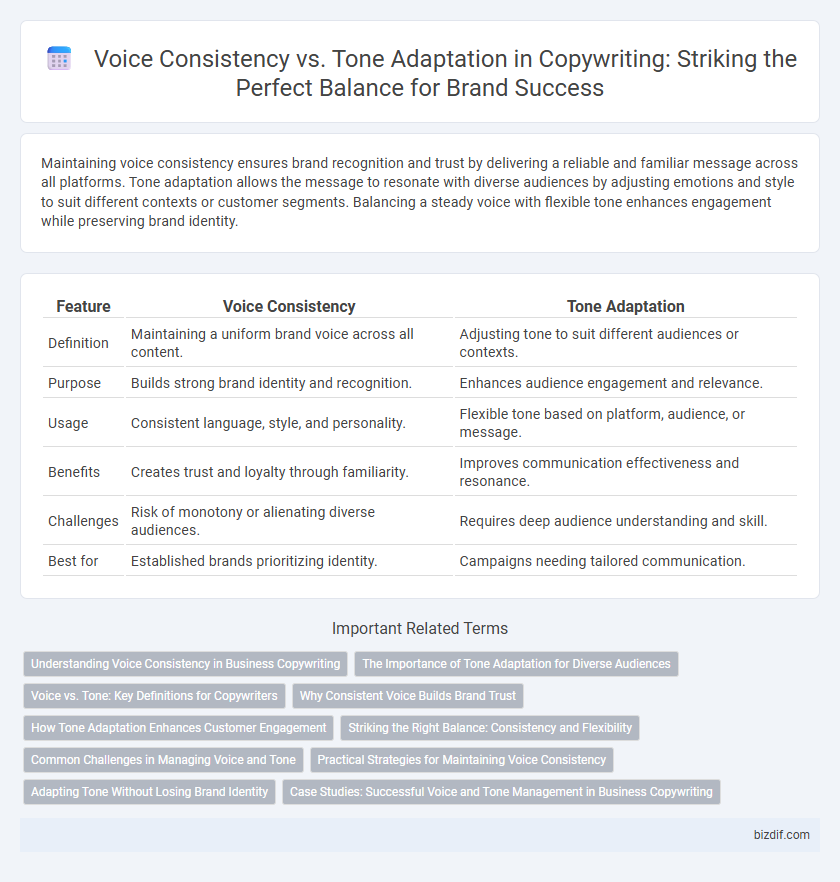Maintaining voice consistency ensures brand recognition and trust by delivering a reliable and familiar message across all platforms. Tone adaptation allows the message to resonate with diverse audiences by adjusting emotions and style to suit different contexts or customer segments. Balancing a steady voice with flexible tone enhances engagement while preserving brand identity.
Table of Comparison
| Feature | Voice Consistency | Tone Adaptation |
|---|---|---|
| Definition | Maintaining a uniform brand voice across all content. | Adjusting tone to suit different audiences or contexts. |
| Purpose | Builds strong brand identity and recognition. | Enhances audience engagement and relevance. |
| Usage | Consistent language, style, and personality. | Flexible tone based on platform, audience, or message. |
| Benefits | Creates trust and loyalty through familiarity. | Improves communication effectiveness and resonance. |
| Challenges | Risk of monotony or alienating diverse audiences. | Requires deep audience understanding and skill. |
| Best for | Established brands prioritizing identity. | Campaigns needing tailored communication. |
Understanding Voice Consistency in Business Copywriting
Voice consistency in business copywriting establishes a recognizable and trustworthy brand identity by maintaining uniform language, style, and personality across all content. It ensures that the brand's core values and messaging resonate clearly with the target audience, reinforcing familiarity and reliability. Consistent voice strengthens emotional connections with customers, enhancing brand loyalty and overall communication effectiveness.
The Importance of Tone Adaptation for Diverse Audiences
Tone adaptation enables brands to connect authentically with diverse audiences by aligning messages with specific cultural, demographic, and situational contexts. Maintaining voice consistency ensures brand recognition, while strategic tone variation enhances engagement and relatability across different platforms and customer segments. Effective copywriting balances voice consistency with tone adaptation to maximize audience resonance and communication impact.
Voice vs. Tone: Key Definitions for Copywriters
Voice is the unique, unchanging personality of a brand expressed consistently across all copy, creating a recognizable identity. Tone adapts to the context, audience, and purpose, shifting to evoke specific emotions or responses without altering the core voice. Understanding the distinction between voice and tone enables copywriters to maintain brand integrity while effectively engaging diverse audiences.
Why Consistent Voice Builds Brand Trust
Maintaining a consistent voice across all marketing channels reinforces brand identity and fosters customer trust by creating a reliable and recognizable experience. Consistent voice helps audiences quickly associate messages with the brand, enhancing credibility and emotional connection. In contrast, frequent shifts in tone can confuse or alienate customers, weakening brand loyalty and overall effectiveness.
How Tone Adaptation Enhances Customer Engagement
Tone adaptation tailors messaging to specific audience emotions, enhancing relatability and customer connection. By adjusting tone according to context, content becomes more engaging, fostering trust and driving conversions. This dynamic approach increases brand loyalty and strengthens overall communication effectiveness.
Striking the Right Balance: Consistency and Flexibility
Maintaining voice consistency ensures brand recognition and trust across all copywriting channels, reinforcing a clear identity. Tone adaptation allows messaging to connect with diverse audiences by adjusting emotional nuances to fit context and platform. Striking the right balance between consistency and flexibility empowers brands to communicate authentically while resonating effectively with varied customer segments.
Common Challenges in Managing Voice and Tone
Maintaining voice consistency while adapting tone poses common challenges such as confusing brand identity and alienating target audiences. Writers often struggle to balance a stable, recognizable voice with the flexibility needed for diverse communication channels and customer segments. Inconsistent voice or inappropriate tone can diminish brand trust and reduce content effectiveness across marketing campaigns.
Practical Strategies for Maintaining Voice Consistency
Maintaining voice consistency in copywriting involves establishing clear brand guidelines that define the core personality and language style across all content channels. Utilizing templates and style guides ensures every piece reflects the brand's distinctive voice while allowing for tailored tone adaptation to suit different audiences and contexts. Regular team training and content audits help reinforce voice consistency and adjust tone effectively without compromising brand identity.
Adapting Tone Without Losing Brand Identity
Maintaining voice consistency while adapting tone is essential for preserving brand identity across diverse platforms and audiences. Effective copywriters adjust language style and emotional cues to resonate contextually without diluting the core brand personality. This balance strengthens customer trust and enhances brand recognition, crucial metrics in content marketing success.
Case Studies: Successful Voice and Tone Management in Business Copywriting
Effective voice consistency in business copywriting ensures brand recognition and trust, as demonstrated by Apple's unwavering minimalist and confident tone across all marketing channels. In contrast, Coca-Cola's tone adaptation strategy adjusts language and emotion to target diverse demographics while maintaining a cheerful and inclusive brand voice. These case studies highlight how balancing a consistent voice with strategic tone adaptation drives customer engagement and loyalty, optimizing brand communication.
Voice Consistency vs Tone Adaptation Infographic

 bizdif.com
bizdif.com